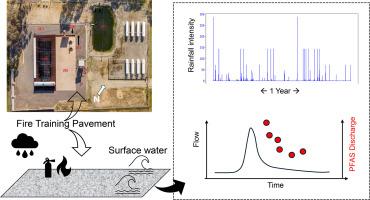Field Measurement and Modelling of PFAS Leachability from a Contaminated Fire Training Area – Whole of Pad Response to Rainfall
IF 12.4
1区 环境科学与生态学
Q1 ENGINEERING, ENVIRONMENTAL
引用次数: 0
Abstract
Per- and polyfluoroalkyl substances (PFAS) have historically infiltrated concrete and asphalt pavements where aqueous film forming foams (AFFF) were used. These pavements can act as long-term sources of PFAS-contaminated runoff, but their contribution is not well quantified. Over 230 rainfall-runoff samples were collected over 335 days from a PFAS-impacted fire training area (FTA) and analysed for 32 PFAS. Rainfall and discharge were monitored, with peak runoff at 1.75 L/s across ∼30 events. Average total PFAS concentrations in runoff events were similar over 11 months (typically 1.0–3.8 µg/L; PFOS 0.50–1.7 µg/L). Within flow events, concentrations decreased at high flows, likely due to dilution, and increased as flows subsided. Composition was consistent throughout, with PFOS dominant (40–60%) and PFHxS, 6:2 FTS, and PFHxA each ∼3–20%. Even after long dry periods, PFAS profiles were unchanged. Annual PFAS discharge was estimated at 75–380 mg/y, with uncertainty at low flows. PFAS at greater than 1 µg/L might discharge over centuries based on estimates of the total mass. Similarly, modelling showed that PFAS might discharge for many decades to centuries. Findings suggest that natural release rates may not meaningfully reduce PFAS discharges over time, thus informing decisions on whether active remediation (e.g., removal, sealing, or water treatment) is warranted at legacy sites.

受污染火灾训练区PFAS浸出能力的现场测量与模拟-整个场地对降雨的反应
从历史上看,全氟烷基和多氟烷基物质(PFAS)一直渗透到使用水成膜泡沫(AFFF)的混凝土和沥青路面中。这些路面可以作为pfas污染径流的长期来源,但它们的贡献尚未得到很好的量化。在335天内,从受PFAS影响的消防训练区收集了230多个降雨径流样本,并对32个PFAS进行了分析。对降雨和流量进行了监测,在约30个事件中,径流峰值为1.75 L/s。径流事件中PFAS的平均总浓度在11个月内相似(通常为1.0-3.8 μ g/L; PFOS为0.50-1.7 μ g/L)。在流动事件中,浓度在高流量时下降,可能是由于稀释,并随着流动减弱而增加。成分始终一致,PFOS占主导地位(40-60%),PFHxS、6:2 FTS和PFHxA各占~ 3-20%。即使经过长时间的干旱期,PFAS分布也没有变化。PFAS年排放量估计为75-380毫克/年,在低流量时不确定。根据对总质量的估计,大于1 μ g/L的PFAS可能在几个世纪内排放。同样,模型显示PFAS可能会排放几十年到几百年。研究结果表明,随着时间的推移,自然释放率可能不会有意义地减少PFAS的排放,因此可以决定是否需要对遗留地点进行主动修复(例如,移除、密封或水处理)。
本文章由计算机程序翻译,如有差异,请以英文原文为准。
求助全文
约1分钟内获得全文
求助全文
来源期刊

Water Research
环境科学-工程:环境
CiteScore
20.80
自引率
9.40%
发文量
1307
审稿时长
38 days
期刊介绍:
Water Research, along with its open access companion journal Water Research X, serves as a platform for publishing original research papers covering various aspects of the science and technology related to the anthropogenic water cycle, water quality, and its management worldwide. The audience targeted by the journal comprises biologists, chemical engineers, chemists, civil engineers, environmental engineers, limnologists, and microbiologists. The scope of the journal include:
•Treatment processes for water and wastewaters (municipal, agricultural, industrial, and on-site treatment), including resource recovery and residuals management;
•Urban hydrology including sewer systems, stormwater management, and green infrastructure;
•Drinking water treatment and distribution;
•Potable and non-potable water reuse;
•Sanitation, public health, and risk assessment;
•Anaerobic digestion, solid and hazardous waste management, including source characterization and the effects and control of leachates and gaseous emissions;
•Contaminants (chemical, microbial, anthropogenic particles such as nanoparticles or microplastics) and related water quality sensing, monitoring, fate, and assessment;
•Anthropogenic impacts on inland, tidal, coastal and urban waters, focusing on surface and ground waters, and point and non-point sources of pollution;
•Environmental restoration, linked to surface water, groundwater and groundwater remediation;
•Analysis of the interfaces between sediments and water, and between water and atmosphere, focusing specifically on anthropogenic impacts;
•Mathematical modelling, systems analysis, machine learning, and beneficial use of big data related to the anthropogenic water cycle;
•Socio-economic, policy, and regulations studies.
 求助内容:
求助内容: 应助结果提醒方式:
应助结果提醒方式:


